Basic Information
-
Gene targeting strategy

-
Gene targeting strategy for B-hPD-1/hLAG3 mice. The exon 2 of mouse Pdcd1 gene that encode the IgV domain was replaced by human PDCD1 exon 2 in B-hPD-1/hLAG3 mice. The exons 2-3 of mouse Lag3 gene that encode the extracellular domain were replaced by human LAG3 exons 2-3 in B-hPD-1/hLAG3 mice.
-
Protein expression analysis

-
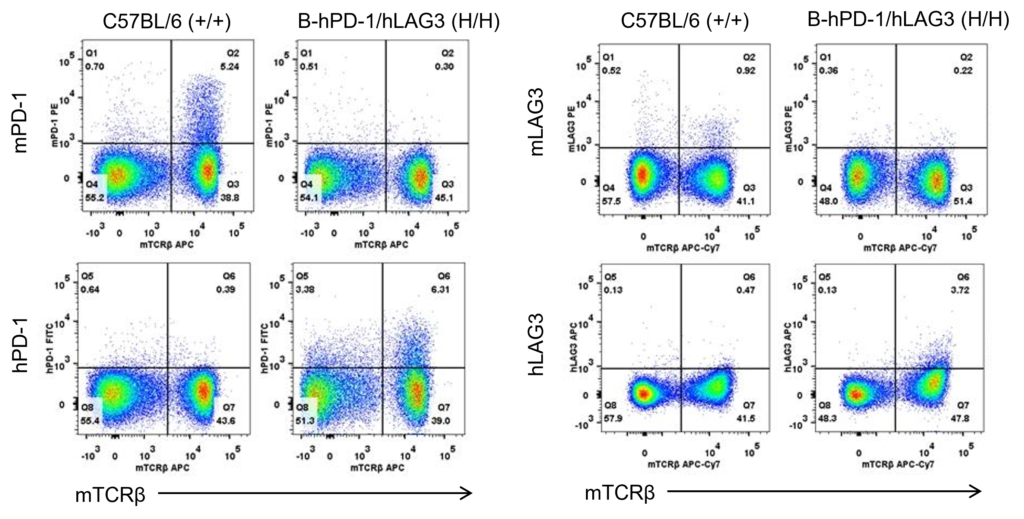
Species-specific PD-1 and LAG3 protein expression analysis in wild-type and humanized B-hPD-1/hLAG3 mice. Splenocytes were isolated from wild-type C57BL/6 (+/+) and homozygous B-hPD-1/hLAG3 (H/H) mice, and analyzed by flow cytometry using species-specific anti-PD-1 and anti-LAG3 antibodies. Mouse PD-1 and LAG3 proteins were detected in wild-type mice, while human PD-1 and LAG3 proteins were detected in B-hPD-1/hLAG3 mice.
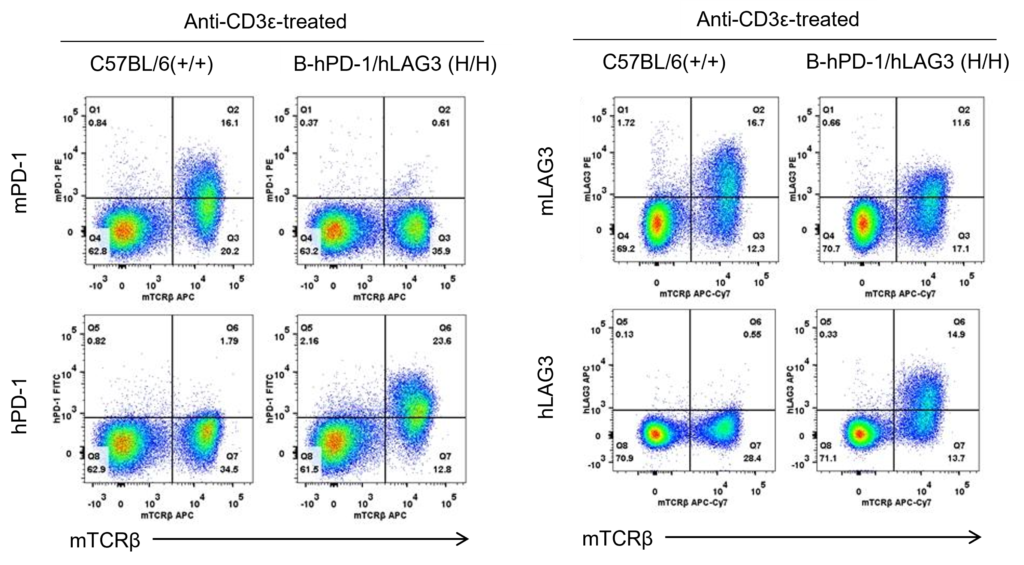
Species-specific PD-1 and LAG3 protein expression analysis in wild-type and humanized B-hPD-1/hLAG3 mice. Splenocytes were isolated from wild-type C57BL/6 (+/+) and homozygous B-hPD-1/hLAG3 (H/H) mice stimulated with anti-CD3ε in vivo, and analyzed by flow cytometry using species-specific anti-PD-1 and anti-LAG3 antibodies. Mouse PD-1 and LAG3 proteins were detected in wild-type mice, and mouse LAG3 was also detected in B-hPD-1/hLAG3 mice, due to cross-reactivity of the antibody. Human PD-1 and LAG3 proteins were only detected in B-hPD-1/hLAG3 mice.
-
Immune cell analysis

-

Analysis of spleen leukocyte subpopulations by flow cytometry. Splenocytes were isolated from female C57BL/6 and B-hPD-1/hLAG3 mice (n=3, 6 week-old) Flow cytometry analysis of the splenocytes was performed to assess leukocyte subpopulations. A. Representative FACS plots. Single live cells were gated for CD45 population and used for further analysis as indicated here. B. Results of FACS analysis. Percent of T, B, NK, Monocyte, DC and macrophage cells in homozygous B-hPD-1/hLAG3 mice were similar to those in the C57BL/6 mice, demonstrating that introduction of hPD-1/hLAG3 in place of its mouse counterpart does not change the overall development, differentiation or distribution of these cell types in spleen.
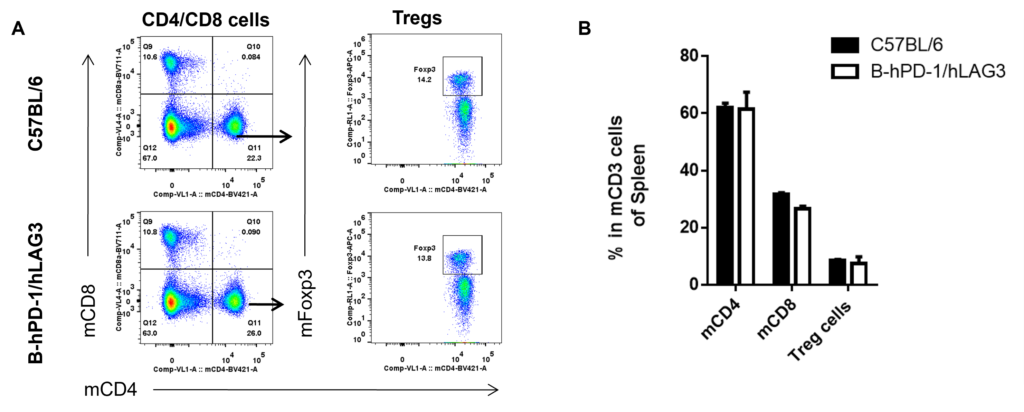
Analysis of spleen T cell subpopulations by flow cytometry. Splenocytes were isolated from female C57BL/6 and B-hPD-1/hLAG3 mice (n=3, 6 week-old). Flow cytometry analysis of the splenocytes was performed to assess leukocyte subpopulations. A. Representative FACS plots. Single live CD45+ cells were gated for CD3 T cell population and used for further analysis as indicated here. B. Results of FACS analysis. Percent of CD8, CD4, and Treg cells in homozygous B-hPD-1/hLAG3 mice were similar to those in the C57BL/6 mice, demonstrating that introduction of hPD-1/hLAG3 in place of its mouse counterpart does not change the overall development, differentiation or distribution of these T cell sub types in spleen. Values are expressed as mean ± SEM.

Analysis of blood leukocyte subpopulations by flow cytometry. Blood was isolated from female C57BL/6 and B-hPD-1/hLAG3 mice (n=3, 6 week-old) Flow cytometry analysis of the blood leukocytes was performed to assess leukocyte subpopulations. A. Representative FACS plots. Single live cells were gated for CD45 population and used for further analysis as indicated here. B. Results of FACS analysis. Percent of T, B, NK, Monocyte, DC and macrophage cells in homozygous B-hPD-1/hLAG3 mice were similar to those in the C57BL/6 mice, demonstrating that introduction of hPD-1/hLAG3 in place of its mouse counterpart does not change the overall development, differentiation or distribution of these cell types in spleen.
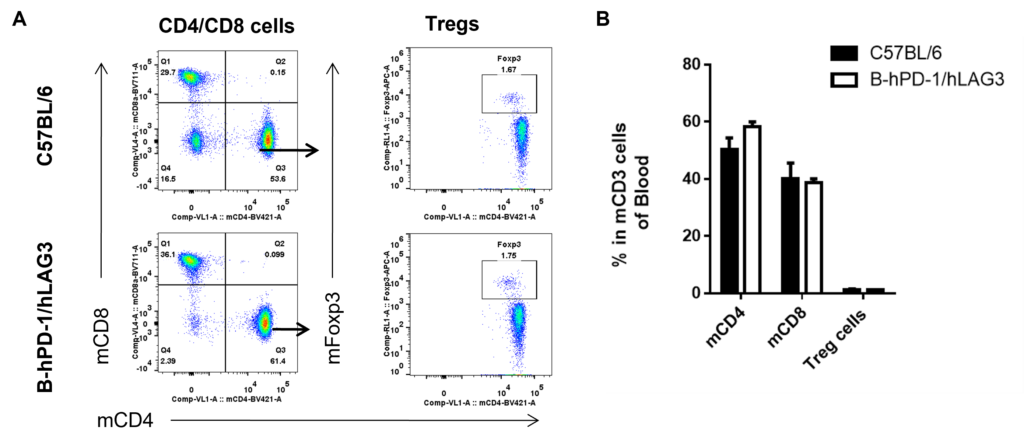
Analysis of blood T cell subpopulations by flow cytometry. Blood was isolated from female C57BL/6 and B-hPD-1/hLAG3 mice (n=3, 6 week-old). Flow cytometry analysis of the blood leukocytes was performed to assess leukocyte subpopulations. A. Representative FACS plots. Single live CD45+ cells were gated for CD3 T cell population and used for further analysis as indicated here. B. Results of FACS analysis. Percent of CD8, CD4, and Treg cells in homozygous B-hPD-1/hLAG3 mice were similar to those in the C57BL/6 mice, demonstrating that introduction of hPD-1/hLAG3 in place of its mouse counterpart does not change the overall development, differentiation or distribution of these T cell sub types in spleen. Values are expressed as mean ± SEM.
-
Complete blood count

-
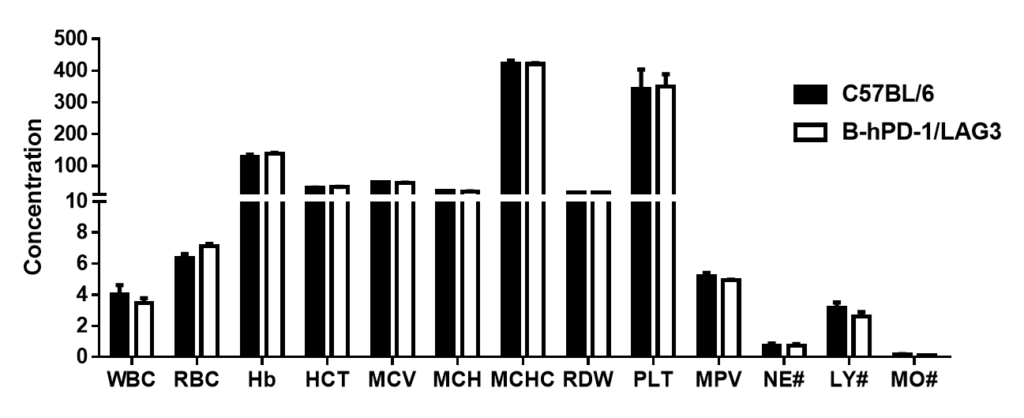
Complete blood count (CBC). Blood from female C57BL/6 and B-hPD-1/hLAG3 mice (n=3, 6 week-old) was collected and analyzed for CBC. There was no differences among any measurement between C57BL/6 and B-hPD-1/hLAG3 mice, indicating that introduction of hPD-1/hLAG3 in place of its mouse counterpart does not change blood cell composition and morphology. Values are expressed as mean ± SEM.
-
Combination therapy in B-hPD-1/hLAG3 mice

-
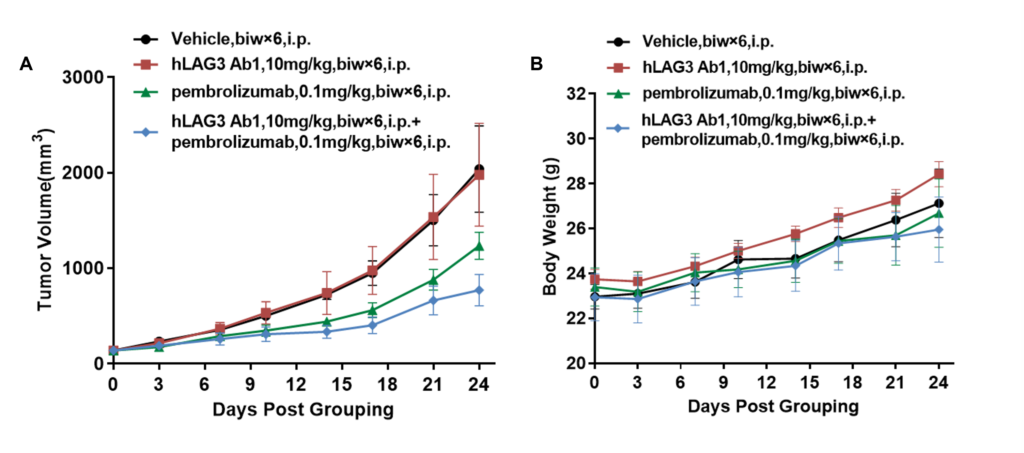
Antitumor activity of anti-human PD-1 antibody combined with anti-human LAG3 antibody in B-hPD-1/hLAG3 mice. Murine colon cancer MC38 cells were subcutaneously implanted into homozygous B-hPD-1/hLAG3 mice (female, 6-7 week-old, n=5). Mice were grouped when tumor volume reached approximately 100 mm3, at which time they were treated with pembrolizumab and anti-human LAG3 antibody with doses and schedules indicated. (A) Anti-human PD-1 antibody combined with anti-human LAG3 antibody inhibited MC38 tumor growth in B-hPD-1/hLAG3 mice. (B) Body weight changes during treatment. As shown in panel A, combination of pembrolizumab and anti-hLAG3 antibody shows more inhibitory effects than individual groups, demonstrating that the B-hPD-1/hLAG3 mice provides a powerful preclinical model for in vivo evaluating combination therapy efficacy of hPD-1 antibodies and hLAG3 antibodies. Values are expressed as mean ± SEM. All antibodies were made in house.
-
Related products

-
B-hPD-1/hPD-L1/hLAG3 plus mice


